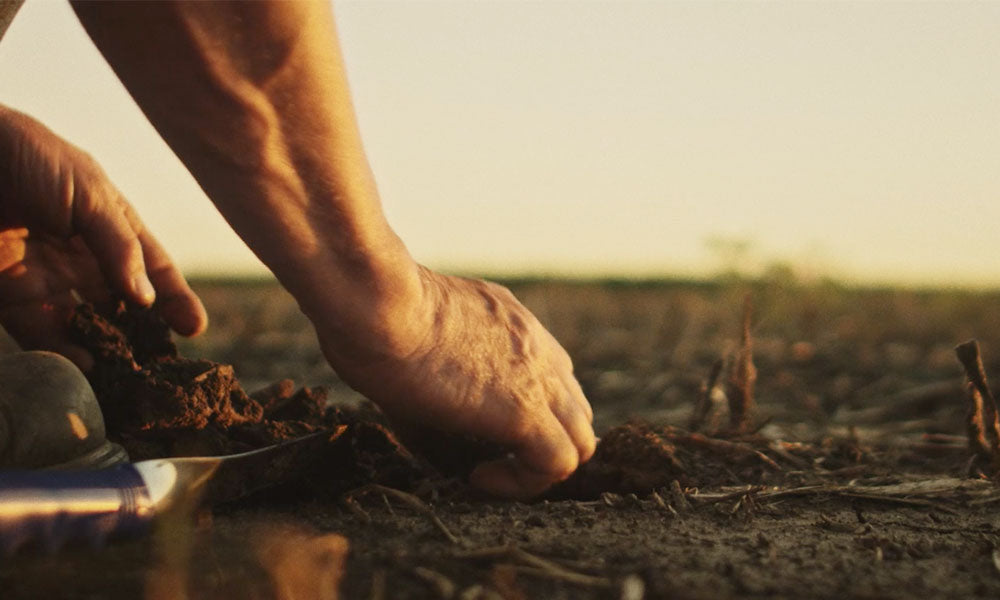For many naturalists and believers alike, the advent of Spring and rituals like the Ash Wednesday observance spur visions of humanity’s eternal “dust-ness” and our earthly connection to all things dirt. Digging into the roots of history, you’ll find that a portion of the Latin name for our species, "Homo" as in Homo sapiens is tied to the word "humus" or "the life of the soil." Even the ancestral creation of the biblical Adam comes from the Hebrew "adamah” meaning “ground" or "of the earth."
As natural textile producers focused on sustainable living, we’ve always believed it's better to grow clothes from the earth rather than engineer them using non-recycled synthetic treatments and petrochemicals, as seen in materials like viscose (also known as rayon or modal) and virgin polyester. Both materials feed into some of the most celebrated "eco-friendly" apparel brands, yet rank among the most destructive to the environment, earning class 'D' and 'E' rankings in the Made-By Environmental Benchmark for Fibres.
When done right, producing organic and recycled fabrics has benefits that impact air, water and soil health, and finally the finished non-toxic product. Whether it is something we put in – or wear on – our bodies, fighting for trends in nature-balanced production models and increasing transparency in supply chains is essential for the future of the planet.
Soil - Food - Health
For only the better part of a decade, America’s scientific community has explored the beneficial microbes inside our guts and their significant connections to our overall health. Not only that, but these little worker bees of the belly have been found to closely mimic the microbiome of one’s local soil and the soil(s) linked to their primary food sources.
In the slow-moving game of science, we are just beginning to understand the role these systems might play in human health, and yet an expanding body of research suggests our gut health is intertwined with several major disease categories, ranging from basic pain and inflammation issues to various types of cancer, and even complex mental disorders like depression and attentional dysfunction.
Thankfully, this deep history between Human and Nature has come to light through the eyes of director Nicol Ragland and her latest documentary – Farmer’s Footprint. Using the work and narratives of regenerative soil expert Allan Williams, PhD. and endocrinologist Zach Bush, M.D., the film investigates the conventional nutritional and agricultural practices driving much of this century’s chronic disease epidemic.
It is certainly no secret that U.S. farmers have relied upon monocultural, chemical-dependent farming strategies for only the past few decades. These often expensive, single-crop agricultural business models quickly became laser focused on industrial scale production and profits, leaving little incentive to question the sustainability and public health risks of such practices, and how marketing agendas drove decisions.
Dr. Williams reflects on his witness to this massive shift in the farming perspective, led by the bold promises of technological, scientific and synthetic methods: “My education told me, ‘No, we aren’t doing things right.’ Suddenly all of things that we didn’t seem to need when I was growing up like the antibiotics and farm chemicals and livestock pharmaceuticals and feed supplements, all of a sudden became very important. And I was convinced if we were going to keep up with the times, we needed that. Over time what I discovered is that we had more problems, not less.”
This blind-faith leap into the future has cost U.S. soils a heavy price, mostly in the form of diminished vitamin and mineral content that’s needed to maintain a living soil – one packed with microbes, bugs and fungi. This rather quiet agricultural revolution has gradually decimated the soil microbiome and the nutrients they help to grow healthy fruits, vegetables, fiber and animal feed producing plants – it's no fiction that an apple in 1950 was notably more nutritious than found in kitchens today.
On top of the worsening malnutrition trend in the U.S., each year our farms are introducing loads of carcinogenic compounds like glyphosate into the ecosystem, erasing the life around you and inside your gut. At this very moment, we face the unique survival puzzle of nutritionally weakened immune systems trying to thrive on a planet growing more toxic.
Due to these profit-focused cropping models, soils are dying. “The average farmer – farming conventionally – is losing more than three to four tons of topsoil per acre annually … that’s untenable, and absolutely unsustainable,” says Williams. “So the very foods that we’re producing out of these soils are heavily degraded, they are deficient in the nutrients that we really need to properly feed our bodies, in creating significant disease issues, neurological disorders and other illnesses that have degraded our health.”

– Grant Breitkruz of Stoney Creek Farm inspecting his topsoil as he transitions to regenerative row cropping in Redwood Falls, Minnesota, via Farmer's Footprint –
Joining Dr. Williams in the storytelling chair is Dr. Zach Bush, whose perspective from his endocrinology clinic sees daily the resulting damage conventional, large-scale agriculture has inflicted on public health. Instead of only addressing the symptoms of his patients, he began to seek answers in the form of gut microbiology, which led him to food, then farms, then finally into the dirt.
Dr. Bush sheds light on the early data that drew him into this field of research: “Between 1996 and 2007, there was a complete reversal of our cancer map in the United States. To see an entire population respond in a single decade to a sudden explosion of cancer suggests that we did something similar to Chernobyl. We did some massive environmental injury that led to this explosive rise in cancer.”
“I cannot turn the tide in my {medical} clinics. I can’t shift the momentum by working with one cancer patient at a time. It’s far too slow, and it’s not at the root of the cause. So I look to these farmers to realize the salvation of human health.”
– Dr. Zach Bush –
So Bush began searching for farmers and scientists like Dr. Williams, those interested in reviving soil through methods that have become what’s known as regenerative agriculture. Regeneration International defines this technique as one that “reverses climate change by rebuilding soil organic matter and restoring degraded soil biodiversity” and with that of course, increasing nutrient density within the soil and food system by applying growing standards that go beyond USDA organic labeling.
To make a life as an average farmer in today’s high cost, pay-to-play world of Big Ag, it's next to impossible to farm without big credit loans and risky seed contracts. Dr. Bush makes clear his feelings regarding the threat posed by increasing farm foreclosures – “We’re looking at the end of this family farm tradition. And as they collapse, we open ourselves up to vulnerability. It’s these multinational organizations that move in with money from China, South America or Russia, all over the world, coming in to buy up massive swaths of the most fertile areas. They’re owning our own land – no longer owned by Americans, let alone the farmers themselves.”
The consumer and public policy are driving many of these market forces, so the best thing you can do is educate yourself, partner with like-minded organizations to make policy change, share your new knowledge as loudly as you can and shop with sustainable earthly values whenever possible. To learn more about regenerative agriculture and its role in the future of human health, watch a clip from the film:
Farmer's Footprint | Regeneration : The Beginning from Farmer's Footprint on Vimeo.






